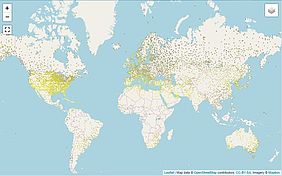Floating solar PV plants are an emerging form of PV systems that float on the surface of drinking water reservoirs, quarry lakes, irrigation canals or remediation and tailing ponds. Floating and land-based PV systems have a similar layout. The only difference is that the PV arrays and often the inverters are mounted on a floating platform. The direct current (DC) electricity is generated by PV modules, gathered by combiner boxes and finally converted to alternating current (AC) by inverters. The PV systems, as well as the inverters, are anchored to the bottom, but it is also possible to connect them to the mainland via floating power lines. Such FPV plants that basically float on man-made lakes can help to alleviate the competition for land use and expand PV capacity in Germany.
Now (2020), the Fraunhofer Institute of Solar Energy Systems ISE commissioned by the renewable energy developer BayWa r.e. investigated the technical potential of floating photovoltaics (FPV) on pit lakes in former lignite mines in Germany. The study estimated a potential PV capacity of 56 GWp for installations on pit lakes in former lignite mines in Germany. After subtracting the estimated area use for recreational activities, tourism, nature and land conservation on pit lakes, there remained an economical potential of 2.74 GWp.
In order to assess the potential for electricity generation on these lakes, researchers interviewed public authorities, stakeholders and experts in authorization, planning, installation and water protection. Pit lakes which were smaller than one hectare or with large fluctuations in depth or lacking possibilities for anchorage on shore were rejected for reasons of costs. The study found that the largest potential was located in Lusatia and the Mid German coal district in Saxony and Saxony-Anhalt. Other types of artificial bodies of water or natural lakes were not considered in this study. In all, the study found that Germany had 4474 man-made lakes. Most of them were formed by surface mining for building materials. This included 725 quarry ponds and 354 gravel lakes. The share of pit lakes from former opencast lignite mines was only 12.9 %.
In the past few years, several other floating PV plants have been installed around the globe. In 2019, the most powerful floating solar PV plant was installed in southern France, marking another milestone in the development of solar energy. The O’MEGA1 project was a 17 megawatt (MW) solar plant situated in Piolenc, a commune in the Vaucluse department, near Orange and Avignon. The project was unique in several ways. To start with, it was the largest in Europe based on floating solar technology. According to its promoters, the floating structure could reduce conflicts over land use and citizens were invited to take a stake in the project.
Also in 2019, the Vienna University of Technology and the Fraunhofer Institute in Germany launched the world’s first floating solar power plant for the marine environment – SolarSea. They succeeded in making it less expensive than the common diesel-generated electricity, a precondition for a gradual replacement of diesel generators through clean solar power solutions in those regions. By using the free space on the water, the technology made large solar systems possible even for islands that did not have enough roofs or land for solar panels. Their floating systems are currently operating in the Maldives and demonstrate great potential for other marine regions. One SolarSea platform annually prevented burning 12 000 l of diesel for generators and could supply 25 households with clean and up to 50% cheaper energy.
A large advantage of FPV is that they exhibit higher land-use efficiency (1.33 MW/hectare). The water on which the PV array floats also provides cooling which results in somewhat higher energy yields. The PV modules and, in most cases, the inverters are installed on floating devices that are anchored either on the shore or the lake bottom. Former lignite opencast mines are also good locations for FPV since a connection to the grid already exists. If an anchoring on land is not possible, then a normal ship anchor can be used. However, this can lead to additional costs, which depend on the lake depth. The electricity generation costs for floating PV systems are about 10 to 15 percent higher than the costs for conventional ground-mounted PV power plants.
Floating PV (FPV) power plants are a relatively new concept, which hold a large potential for electricity generation worldwide, not least because it allows a land-neutral expansion of photovoltaic capacity. Scientists believe that in order to avoid time-consuming changes to planning land use the land-neutral floating PV technology should be given a privileged position, as is already the case today for the use of land for wind and nuclear power plants.
